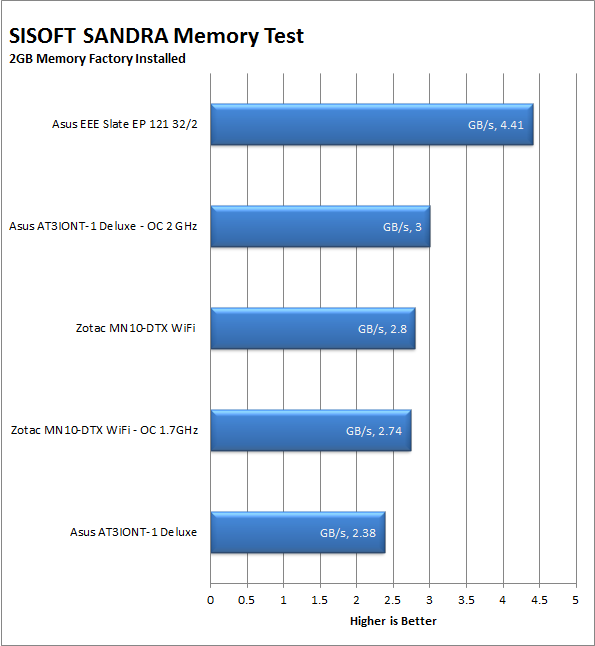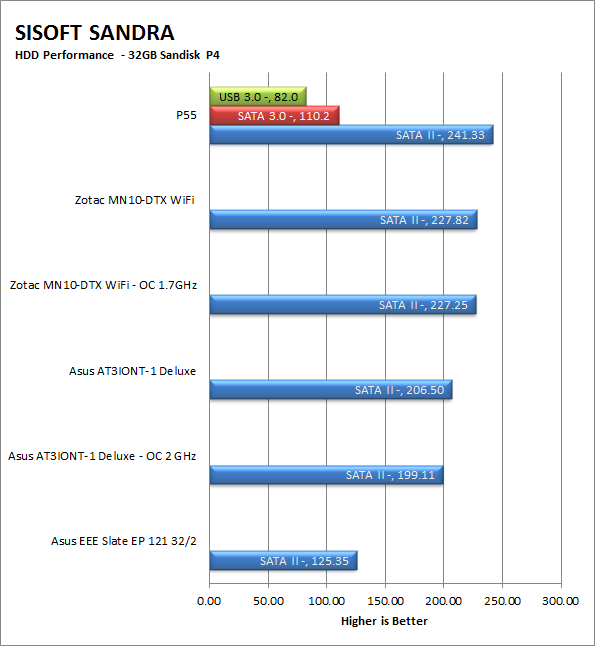Section 1 Subsystems -
Memory -
Memory performance is very important on a motherboard, especially when you have a CPU with multiple cores and threads. If you have slow memory your cores and threads can become starved for data to execute. To test memory performance we ran Sisoft’s SANDRA to gauge the basic bandwidth available.

The EEE Slate has the same IMC (Internal Memory Controller) that is found in all Core CPUs. This does give it the upper hand here in our testing group as most of these still rely on the Northbridge of the chipset to handle memory performance. This adds in some automatic latency that drags at the memory speed on many Atom based products. With this extra speed here we should see some decent performance in general computing as well as certain transcoding applications such as iTunes and Zune.
Drive performance -
Drive performance is also one of the major subsystems that goes to make up the performance of a motherboard. For our testing we use Sandra and Everest again.

Drive performance suffered a little on the EP121. Much of this is probably due to the Sandisk SSD. Sandisk is honestly not known for its high levels of performance. They are stable and relatively inexpensive compared to other manufacturers out there so this is likely why they are in this product. Applications like file copy, transcoding, photo-manipulation and video playback can be affected by this lack of speed. However, the memory performance will compensate for some of this as well.
Power and Battery Life -
Power efficiency is another of those misnomers that we get caught up in. We hear about idle states and power gates. But what does that mean to you and I? On the surface having power management that reduces idle power sounds great and can be a benefit to someone that leaves their system on for long periods of time (and inactive) but how a system handles power under load and the delta between the two states is often more important than the idle power usage numbers. We use only P3 Kill A Watt instruments for measuring power. Battery Life was measured under normal usage with the Wireless adapter on, an SD card in the system and with the balanced power management setting in use. We ran the system until it shut down a total of five times then chose the median number (the one in the middle) to determine the average battery life on the EEE Slate EP121.
Power draw from the wall was ridiculously minimal. Under idle conditions or when doing simple tasks we pulled a total of 12 Watts from the wall. Even under the most extreme tests we could run (HyperPi 32M on all four “cores” and with our Evo plugged into the charging port) we only pulled a whopping 32 Watts of power from the Wall.
Our Battery Life was a little on the disappointing side at first. It seems that when I was reviewing the numbers I was thinking about the EEE Slate as just another tablet. This is not even close to what it is; the EP121 is more like a small laptop than your typical tablet that is out on the market. Asus did go light on the battery to save on weight but even with the skimpy 4 cell battery we were hitting an average of 4 hours and 23 minutes. This is an improvement to what the internet is generally claiming out there. I have read reports of 3 hours to some that are as bad as 2 hours. It seems that some people are throwing around some less than accurate information. Even watching a 720P HD video (as an MKV file) we were able to pull off about 3 hours of battery life. True it is not the 6 hours that we saw with the iPad, but considering the hardware differences this is not bad at all.
Cooling -
Cooling is an important factor in product performance and longevity. Components like the chipset, VRM modules and even capacitors need to be kept relatively cool to prevent failure. As these parts are made of silicon, they have a thermal breakdown threshold; or melting point. At that temperature the actual transistors built into chip will begin to deform and break down. Granted, the threshold is often very high, but you still need to make sure that components stay away from this level of heat for longer product life.
The EEE Pad uses a fairly typical form of heat-pipe cooling found in most laptops and notebooks today. This is assisted by the dual squirrel cage fans that push the hot air out the top of the device. Again an aluminum back casing would have helped the thermal performance but the plastic one that is currently used. Even under the most stressful conditions the EEE Slate EP121 was still not even warm and more than cool enough to hold in your bare hand or place on your lap without discomfort.
Audio -
Audio is highly subjective. What we find pleasing may sound “off” to you. That is always going to the problem with testing audio; results will vary too widely depending on the tastes of the listener. However, there are ways of measuring the audio output with an objective ear. There is also the issue of audio causing performance issues in gaming and video playback. The reason this is a potential source of concern is that all onboard audio CODECs (Compression/Decompression) are CPU controlled. This means that while the audio chip controls the audio levels and effects of the audio the actual work is done on the CPU. Usually this will not be a problem with today’s powerful CPUs. Even the lower and consumer level products can handle high-end audio these days. But again there is the chance that a bad design or software will hinder your system and performance. On the other side the limits of board space, cost, etc will also prevent the level of audio quality you can get from an add-in board. We test all audio parts with three media types, Movie (DVD), MP3 Music, and Gaming. These are pushed to our Tec On model 55 Tube Amp to see if we can detect any signal issues in the reproduction.
The EEE Slate uses one of RealTech Audio’s HD CODECs. This gives decent sound for the small stereo speakers but the power behind them is just not enough. We often had to strain to hear the audio from video files and even some MP3/MP4s. The headphone audio was much better and even seemed a little cleaner than the speakers. Perhaps in future revisions Asus can put in a small Amp for the speakers and headphones to give them a little extra punch.
Networking -
This one is something that is a requirement anymore. If you have a computer, the chances are good (like 99%) that you are also connected to high-speed internet. With this you need a good and solid LAN chip to make sure that your data flows properly out and back.
The EP121 has an Atheros AR9002WB-1NG wireless adapter. This does fairly well at keeping you connected but does have a little bit of a range issue. While we typically connected at 150Mbps when within direct line-of-site once we had a couple of walls between us and the access point we lost some of that and saw connection speeds drop to 70 or below. When we put in another adapter (the TRENDNet TEW-664UB) we saw this jump back up to the 150Mbps range. The problem seems to be one of either the antenna or interference by internal components that reduce the effective range. Still it is not as bad as some laptop/netbook adapters that have their performance cut by up to 70% once out of line-of-site.




